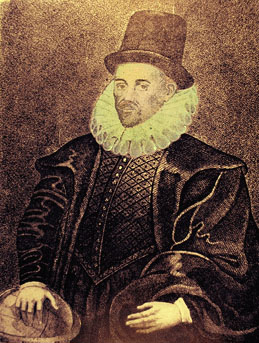| William Gilbert  Born: 24-May-1544 Born: 24-May-1544
Birthplace: Colchester, Essex, England
Died: 10-Dec-1603
Location of death: London, England
Cause of death: Bubonic Plague
Gender: Male
Race or Ethnicity: White
Sexual orientation: Straight
Occupation: Physicist, Doctor Nationality: England
Executive summary: De Magnete William Gilbert, or Gylberde, the most distinguished man of science in England during the reign of Queen Elizabeth I, and the father of electric and magnetic science, was a member of an ancient Suffolk family, long resident in Clare, and was born on the 24th of May 1544 at Colchester, where his father, Hierome Gilbert, became recorder. Educated at Colchester school, he entered St. John's College, Cambridge in 1558, and after taking the degrees of BA and MA, in due course, graduated MD in 1569, in which year he was elected a senior fellow of his college. Soon afterwards he left Cambridge, and after spending three years in Italy and other parts of Europe, settled in 1573 in London, where he practiced as a physician with "great success and applause." He was admitted to the College of Physicians probably about 1576, and from 1581 to 1590 was one of the censors. In 1587 he became treasurer, holding the office until 1592, and in 1589 he was one of the committee appointed to superintend the preparation of the Pharmacopoeia Londinensis which the college in that year decided to issue, but which did not actually appear until 1618. In 1597 he was again chosen treasurer, becoming at the same time consiliarius, and in 1599 he succeeded to the presidency. Two years later he was appointed physician to Queen Elizabeth, with the usual emolument of £100 a year. After this time he seems to have removed to the court, vacating his residence, Wingfield House, which was on Peter's Hill, between Upper Thames Street and Little Knightrider Street, and close to the house of the College of Physicians. On the death of the queen in 1603 he was reappointed by her successor; but he did not long enjoy the honor, for he died, probably of the plague, on the 30th of November (10th of December, new style) 1603, either in London or in Colchester. He was buried in the latter town, in the chancel of Holy Trinity church, where a monument was erected to his memory. To the College of Physicians he left his books, globes, instruments and minerals, but they were destroyed in the great fire of London.
Gilbert's principal work is his treatise on magnetism, entitled De magnete, magneticisque corporibus, et de magno magnete tellure (London, 1600). This work, which embodied the results of many years research, was distinguished by its strict adherence to the scientific method of investigation by experiment, and by the originality of its matter, containing, as it does, an account of the author's experiments on magnets and on electrical attractions, and also his great conception that the earth is nothing but a large magnet, and that it is this which explains, not only the direction of the magnetic needle north and south, but also the variation and dipping or inclination of the needle. Gilbert's is therefore not merely the first, but the most important, systematic contribution to the sciences of electricity and magnetism. A posthumous work of Gilbert's was edited by his brother, also called William, from two manuscripts in the possession of Sir William Boswell; its title is De mundo nostro sublunari philosophia nova (Amsterdam, 1651). He is the reputed inventor besides of two instruments to enable sailors "to find out the latitude without seeing of sun, moon or stars", an account of which is given in Thomas Blondeville's Theoriques of the Planets (London, 1602). He was also the first advocate of Copernican views in England, and he concluded that the fixed stars are not all at the same distance from the earth.
It is a matter of great regret for the historian of chemistry that Gilbert left nothing on that branch of science, to which he was deeply devoted, "attaining to great exactness therein." So at least says Thomas Fuller, who in his Worthies of England prophesied truly how he would be afterwards known: "Mahomet's tomb at Mecca", he says, "is said strangely to hang up, attracted by some invisible loadstone; but the memory of this doctor will never fall to the ground, which his incomparable book De magnete will support to eternity."
Father: Hierome Gilbert (recorder)
High School: Colchester School, Colchester, England
University: BA, St. John's College, Cambridge University (1560)
University: MA, St. John's College, Cambridge University (1564)
Medical School: MD, St. John's College, Cambridge University (1569)
College of Physicians President (1600)
Author of books:
De Magnete, Magneticisque Corporibus, et de Magno Magnete Tellure (1600)
De Mundo Nostro Sublunari Philosophia Nova (1651)
Do you know something we don't?
Submit a correction or make a comment about this profile
Copyright ©2019 Soylent Communications
|